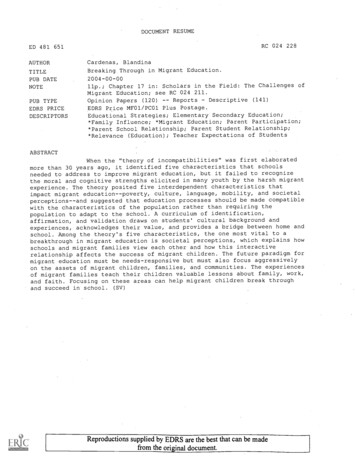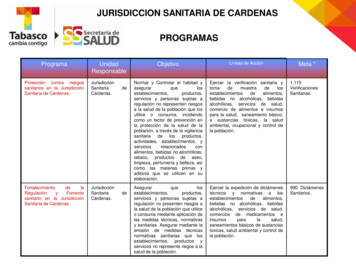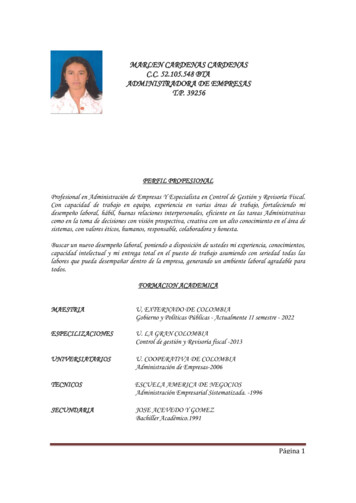
Transcription
DOCUMENT RESUMEED 481 651AUTHORTITLEPUB DATENOTEPUB TYPEEDRS PRICEDESCRIPTORSRC 024 228Cardenas, BlandinaBreaking Through in Migrant Education.2004-00-00llp.; Chapter 17 in: Scholars in the Field: The Challenges ofMigrant Education; see RC 024 211.Descriptive (141)ReportsOpinion Papers (120)EDRS Price MF01/PC01 Plus Postage.Educational Strategies; Elementary Secondary Education;*Family Influence; *Migrant Education; Parent Participation;*Parent School Relationship; Parent Student Relationship;*Relevance (Education); Teacher Expectations of StudentsABSTRACTWhen the "theory of incompatibilities" was first elaboratedmore than 30 years ago, it identified five characteristics that schoolsneeded to address to improve migrant education, but it failed to recognizethe moral and cognitive strengths elicited in many youth by the harsh migrantexperience. The theory posited five interdependent characteristics thatimpact migrant education--poverty, culture, language, mobility, and societalperceptions--and suggested that education processes should be made compatiblewith the characteristics of the population rather than requiring thepopulation to adapt to the school. A curriculum of identification,affirmation, and validation draws on students' cultural background andexperiences, acknowledges their value, and provides a bridge between home andschool. Among the theory's five characteristics, the one most vital to abreakthrough in migrant education is societal perceptions, which explains howschools and migrant families view each other and how this interactiverelationship affects the success of migrant children. The future paradigm formigrant education must be needs-responsive but must also focus aggressivelyon the assets of migrant children, families, and communities. The experiencesof migrant families teach their children valuable lessons about family, work,and faith. Focusing on these areas can help migrant children break throughand succeed in school. (SV)Reproductions supplied by EDRS are the best that can be madefrom the original document.
1LU.S. DEPARTMENT OF EDUCATIONPERMISSION TO REPRODUCE ANDDISSEMINATE THIS MATERIAL HASBEEN GRANTED BYOffice of Educational Research and ImprovementEDATIONAL RESOURCES INFORMATIONCENTER (ERIC)This document has been reproduced asreceived from the person or organizationoriginating it.Caro leBer-ry0 Minor changes have been made toimprove reproduction quality.TO THE EDUCATIONAL RESOURCESINFORMATION CENTER (ERIC)CHAPTER 17Points of view or opinions stated in thisdocument do not necessarily representofficial OERI position or policy.Breaking Through in Migrant Education1BY BLANDINA CARDENASMore than thirty years ago, in the "Theory of Incompatibilities," José Cárdenas and I described the persistent failure ofschools to educate migrant students. Today, the childrenwho harvest the food we eat still experience a harsh life, and schoolscontinue to ignore the importance of migrant children's experiences.José and I grew up in stable middle-class homes in segregatedsouthern Texas. Our neighborhoods and schools would lose morethan half their populations in early .spring as families boarded the bigtrucks that took them to pick cherries, apricots, lechuga (lettuce), andbetabel (sugar beets). We listened as our friends came home withstories of travel and adventure in exotic places like Wisconsin,Michigan, and Idaho, and we believed. They returned to our classrooms from late September to early November and seemed stronger,more savvy, quicker to problem-solve, and weary and wise in ways'In 2002, Francisco Jiménez received the Tomás Rivera Children's Book Awardfrom Southwest Texas University for his autobiographical works The Circuit andBreaking Through. I use the breaking through metaphor with profound respectand appreciation for the insight and inspiration gained from his moving stories ofindividual and family strength in the face of grinding poverty, discrimination, andimpermanence.241BEST COPY AVAILABLE()2
CHAPTER SEVENTEENwe recognized but did not understand. A few struggled to catch upwith lost instruction and quickly became competitive; many morebarely got by or tuned out altogether. On a deep, partly unconsciouslevel, we believed our migrant friends had assets and were every bit ascapable of excelling in academics as we were.Why the Theory of Incompatibilities?In developing the Theory Of Incompatibilities, we relied on thelargely quantitative social science research methods supported by theeducation research funding of the late 1960s and early 1970s. Welooked at systems and characteristics. What escaped our analysis wasa sufficient appreciation for the harshness of migrant life and themoral and cognitive strength it elicitsa strength schools either donot recognize or are unable to tap.Since the passage of the Elementary and Secondary Education Actof 1965, federal funding for migrant education has flowed from the-Title I Migrant Education Program, Head Start Indian and migrantallocations, the College Assistance Migrant Program, and other initiatives. Years of experimentation and advances in technology finallyhave resulted in an education record transfer system, although incompatibilities in requirements among states remain a barrier. Successstories among former migrant students are numerous and includeindividuals who have served in Congress, state legislatures, law,medicine, the military, and positions of leadership in higher educationand public schools.But the glass is still at least half empty when it comes to migranteducation. Too many success stories occur in spite of the educationsystem, not because of it. Schools have not made sufficient strides inadapting processes and instruction to the needs and assets of childrenwhose life chances are shaped by the harshness of fieldwork. Exposure to agricultural chemicals still menaces families in the field. Theeffects of irregular immigration and migrant labor are either ignored orattacked. An education system structured historically to serve anagriculture-based economy now is unable to restructure its beliefs andprocesses to serve the children of workers whose backbreaking laborputs food on our tables. Schools must find ways to connect with thecreative and productive potential that migrant children demonstratesimply by surviving.242
ILBREAKING THROUGH IN MIGRANT EDUCATIONThe Theory of Incompatibilities posited that five interdependentcharacteristics have an impact on migrant education: poverty, culture,language, mobility, and societal perceptions. Schools must considereach characteristic in adapting education services and programs to theneeds and the strengths of Mexican American migrant children.Education processesfrom governance, to curriculum, to pupil services, to evaluationshould be made compatible with the characteristics of the population rather than requiring the population to adaptto the school. The effects of these conditions likely have become moreacute in a population battered by economic, immigration, familial,and cultural forces more demanding than those of a third of a centuryago. Implementation of the Theory of Incompatibilities today requiresparticular attention to the binational nature of mobility, psychologicalpressures of immigration and irregular status, cultural and structuralchanges in families, health needs attendant to working in toxicenvironments, and exacerbated effects of living in extreme poverty ina high-cost economy.Curriculum of Identification, Affirmation, and ValidationFrancisco Jiménei describes a moment of deep learning andinsightful teaching that says everything the Theory of Incompatibilitiesintended to communicate. As a high school sophomore, Jiménezstruggled with English language, grammar, composition, and comprehension. Charged to write an autobiographical composition, he didnot want his teacher Miss Bell to know he had entered the countryillegally. Instead, he wrote about the time his baby brother had nearlydied in a migrant labor tent city. His paper was returned with a sea ofred marks and a note to see Miss Bell after class."Is what you wrote a true story?" Miss Bell asked."Yes," I answered, feeling anxious."I thought so," she said smiling. "It's a very moving story.Did your brother die?""Oh no!" I exclaimed. "He almost did, but God savedhim.""Now, let's look at your paper.""Your writing shows promise. If you're able to overcomethe difficulties like the one you describe in your paper andyou continue working as hard as you have, you're going to243
VA?CHAPTER SEVENTEENsucceed." She gave me back the paper and added, "Here takeit home, make corrections, and turn it in to me tomorrow afterclass."When he submitted the revised paper, Miss Bell handed him a bookand asked, "Have you read The Grapes of Wrath?""No," I said, wondering what the word wrath meant.Grabbing every moment to read the boOk and continuously lookingup unfamiliar words, Jimenez absorbed the Joads even into hisdreams:I kept struggling with the reading, but I could not put it down.I finally understood what Miss Bell meant when she told meto read for enjoyment. I could relate to what I was reading.The Joad family was poor and traveled from place to place inan old jalopy, looking for work. They picked grapes andcotton and lived in labor camps similar to the ones we lived inlike Tent City in Santa Maria. Ma Joad was like Mama and PaJoad was a lot like Papa. Even though they were not Mexicanand spoke only English, they had many of the same experi-ences as my family. I felt for them. I got angry with thegrowers who mistreated them and was glad when Tom Joadprotested and fought for their rights. He reminded me of myfriend Don Gabriel, the bracero who stood up to Diaz, thelabor contractor, who tried to force Don Gabriel to pull aplow like an ox.2Applying the intuition many good teachers possess, Miss Bellcreated compatibility between the curriculum and her student. Sheoffered a curriculum of identification, affirmation, and validation.Moreover, she focused on Jiménez's assets rather than his deficits andgave him a lifeline to her high expectations and standards. Whileissues of culture and language were not in her imagination, sheresponded to the characteristics of poverty and mobility. Most important, she responded to the characteristic of societal perceptions. She2Francisco Jiménez, Breaking Through (Boston: Houghton Mifflin, 2001), 98-102.244f"-P
11-7rAwisILBREAKING THROUGH IN MIGRANT EDUCATIONlet Jimenez know he belonged in her demanding class and recognizedhe was transforming the adversity in his life into something valuable.My own Mexican American migrant students taught me about thecurriculum of identification, affirmation, and validation, and thatchanging the curriculum is not enough. I entered the dusty, hotbarrack that was the site of my first teaching assignment in mid-April1967. My third graders were migrants (because the other third-gradeteacher did not like migrants), African Americans (because the otherthird-grade teacher did not like African Americans), and the Padillaboys (because the other third-grade teacher had taught their fathersand did not want to teach any more Padillas). Almost all the AfricanAmerican students were migrants and spoke Spanish. The previousteacher had left me a class as chaotic as any scene Hollywood mightdevise.Mostly male, my students' ages spanned 10 years, with the giftedPadilla boys slightly underage for their grade. I had never had aneducation course and never heard the terms bilingual education ormulticultural education. The principal handed me the overheadprojector, purchased recently with Title I funds, and told me not toworry because the class would soon thin out as the Migrants left.Unable to control the students, I resorted to bribery. I brought a caketo class and promised the students a party if they behaved. Everyonebut the Padilla boys saved the cake to take home to their mothers. Thenext day, I took two cakes, one for the students to eat in class and oneto be divided up for their mothers. As my students left, I called one ofthem .mijo, the endearing version of mi bijo, or my son. Laughing andteasing, the students asked me if the boy really was my son. When Iexplained they all were my sons, of sorts, they all wanted me to callthem mijo. I agreed.Every day, I baked two cakes. Slowly, my classroom became ajoyous place. Absences were nonexistent. One of my favorite storieswas Benito Judrez, Mexico's only Indigenous president. While work-ing in the fields and protecting his sheep from wolves, he learnedlessons that served him well in defeating the French and savingMexico's democracy. I went to the storeroom and found some oldthird-grade readers that described Judrez's life. With too few books, Igrouped my students and had them read along as I read to them. Mystudents were spellbound. After a raucous discussion of their own245
HILHCHAPTER SEVENTEENexperiencesincluding some of dubious veracity involving fields,mountains, sheep, and wolvesI assigned each student to read thebook to their parents and report on what more they had learned aboutBenito Judrez. Every day for the next week, the students came backwith their families' stories about Judrez. I did not know it then, but Ihad created the optimal environment for oral English language development, a pressing need among most of my students.When the first student started talking about leaving to go to "theworks," I felt I had to do something to keep him in school. I urged hisfamily to keep him in school until after the exam. It worked. For thenext few weeks, I spent my afternoons traipsing through the barrioand talking with every migrant head of household. Unaware of how adelayed departure could affect a fainily's income, I made a convincingcase for the importance of education. Perhaps it was that I was 22years old, that my Spanish was formal and respectful, or that my cakeshad preceded me, but all but one student remained through the end ofthe term.From these third-grade students and their families, I gained theessential understandings that have shaped my work in education andmy advocacy for children. The cake scenario provided insight into thepowerful role culture plays in motivating all learners. I realized thatthe most important role for these Mexican American students was tobe a family member and that these close family ties could be amotivational and teaching tool. I have used the curriculum of identification, affirmation, and validation in all my teaching regardless of thestudents' education levels or cultural, ethnic, or racial backgrounds.A growing number of former migrants are writing about theirexperiences, providing a deeper understanding of migrant children'scomplex lives and the impact of immigration, impermanency, language isolation, and hard labor on education.3 These voices reflect thecomplexity of challenges, needs, and strengths of migrant families.Going forward, the actual stories of migrants must be at the center of3Tornds Rivera reflects the experiences of long-term, U.S.-citizen, South Texasfamilies who leave a stable community yearly to labor in agricultural fields. SeeJulian Olivares, ed., Tomds Rivera: The Complete Works (Houston: Arte Publico,1991). Other autobiographical accounts include Jimenez, Breaking Through, andJosie Mendez-Negrete, Las Hijas de Juan: Daughters Betrayed (San Jose, CA:Chusma House, 2002).246IF
ILEMMENBREAKING THROUGH IN MIGRANT EDUCATIONadvocacy and efforts to improve the education and life chances ofmigrant children and their families.In a riveting first-person description of her childhood, JosieMendez-Negrete describes the ache of leaving her close-knit, lovefilled village in Mexico and her introduction to life in the land ofopportunity:Not wanting to be arrimados ("spongers"), we stayed onlylong enough to make the money we needed to get to the nextplace. Mague and I were drafted into the fields. We lost ourappetite for apples or any of the fruits we picked. Hated thescent of ripe fruit that clung to our clothes and turned ourstomach. Felt as if we had been drenched in cheap perfumeall day long.We didn't have drinking water, and we had to hold ourbladder or go behind the bushes in view of the other workers.Never had breaks, forced to keep up an adult pace. Tinbuckets we carried cut into our fingers and blistered themuntil we grew calluses on our palms.'For Mendez-Negrete, immigration and impermanence meant isolationfrom her native community and her constantly changing world in theUnited States. The Theory of Incompatibilities focused attention onthe need to bridge these experiences.Building a Model of AdvocacyJosé Cárdenas and I often have been asked to single out the mostimportant characteristic identified in the Theory of Incompatibilities.Bilingual educators expect us to cite language; migrant educatorsfocus on mobility; compensatory education specialists point to poverty. We have declined to answer, rejecting the tendency of reformersto look for a silver bullet to produce quick results. In private,however, we have always agreed the prerequisite for a breakthroughis embedded in the characteristic we call societal perceptions.The concept of societal perceptions emerged from consistent dataindicating migrant parents are concerned about schools' attitudes4Mendez-Negrete, Las Hijas cle Juan.247
CHAPTER SEVENTEENtoward them and their children. In 1969, parents reported feelingunwelcome in schools, being subjected to inferior teachers or classrooms after returning to their home schools, and multiple otherslights. As we probed deeper, particularly with multigenerationalmigrant families, it became clear the parents' feelings had as much todo with their own experiences of rejection, discrimination, and failurein school as it did with their children's experiences. Societal perceptions explain how schools and families view each other and how thisinteractive relationship affects the success of migrant children. It isequally important to respond to schools' negative or dysfunctionalperceptions of migrant students and their families as it is to addressthe negative or dysfunctional perceptions migrant students and theirfamilies have of schools.The concept of societal perceptions initially proved difficult tomanage. Defensive school personnel grasped that migrant parentsmight have negative attitudes toward education. Migrant educationadvocates focused on societal perceptions to affirm the existence ofschools' discriminatory attitudes. Our position was that all the factorsinterrelate and that affirmative steps must be taken with regard toindividual students, parents, and school personnel to develop positiveperceptions and expectations.In today's terms, we would say the paradigm on migrant familiesand their schooling must shift to achieve a significant breakthrough ineducation outcomes. Indeed, the Theory of Incompatibilities repre-(4.)sented a weak paradigm shift, calling on educators to look not atdeficits but at the disconnect between a school's expectations andwhat the students bring to school. We referred to needs and, moreweakly, to strengths. The future paradigm for migrant education mustbe needs-responsive but also must focus aggressively on the assets ofmigrant children, families, and communities.John Kretzmann and John McKnight have developed an assetsbased community-development model that focuses on building community in urban settings; however, many of the strategies could workin migrant communities and school districts with new migrant orimmigrant populations and limited resources. Kretzmann and McKnightcall for mapping assets, building relationships, releasing individualand organizational capacities in communities, and capturing localinstitutional resources. Migrant communities, whether temporary or2489IF
ILBREAKING THROUGH IN MIGRANT EDUCATIONpermanent, have numerous assets to help schools better serve children. Migrant workers survive by using informal communicationnetworks, kinship groups, and groups based on location of origin.People influence one another based upon a sophisticated assessmentof the knowledge, skills, and wisdom relative to each challenge theyconfront. These assets, if recognized by schools, can serve as resources to benefit children.5Luis Moll and James B. Greenberg demonstrate that an advancedclassroom pedagogy requires a full understanding of how students'households express their own pedagogies. Social relations and meansof production connect households to one another and help transmit"funds of knowledge" among participants. These transactions areextended zones of proximal development that can inform the mediation of instruction and transform classrooms into more advancedcontexts for teaching and learning. A recent model engages parents toexamine the funds of knowledge in their own household interactionswith strategies that mediate their children's learning. This model goesbeyond understanding that migrants have assets; the new paradigmunderstands that migrants are assets.6In the spring of 1998, Jaime Chahin and I traveled to the centralgulf coast of Florida to study tutoring programs.' Expecting that TitleIchildren in that part of the country would be largely AfricanAmerican and White, we were surprised to see that most of the peoplein one small town were young Mexican men. By the end of the day,we were anxious to explore the area and figure out why all theseMexican men were there. We looked in the Catholic Church but foundno one. Before long, we found a thriving Mexican food restaurant and5John P. Kretzmann and John L. McKnight, Building Communities from the InsideOut: A Path Toward Finding and Mobilizing a Community's Assets (Chicago:Acta, 1993).6Luis C. Moll and James B. Greenberg, "Creating Zones of Possibilities: CombiningSocial Context for Instruction," in Vygotsky and Education: Instructional Implications and Applications of Sociohistorical Psychology, ed. Luis C. Moll (Cambridge:Cambridge University Press, 1990); and Belinda B. Flores, Mari Riojas-Cortez, andEllen Clark, "Los Ninos Aprenden en Casa," in Young Child (forthcoming).'Dr. Jaime Chahin subsequently developed the "Las Colonias" project to informthe public and policymakers about the needs and assets of the 500,000 mostlymigrant families who live in unincorporated neighborhoods along the MexicoU.S. border.249BESTCOPY AVAILABLE
0CHAPTER SEVENTEENa waitress in her late teens with an engaging personality and intelligence to spare.She explained how her family made their way from the Mexicanstate of Oaxaca to the Florida gulf coast: "We walked," she said, inflawless English. "You walked?" we exclaimed. She enrolled in schoolat age six and recently graduated third in her class. She wanteddesperately to attend college, but her immigration status denied heraccess to financial aid. During the discussion, we kept coming back tothe remarkable story of how she walked with her father and sisterfrom Oaxaca to the Florida gulf coast: "We walked up to Sonora andcrossed through the desert and then walked across through Oklahomaand Arkansas."We were awestruck by her story and assertion that many of themigrant workers in the town had taken the same trek. Invisible to theAmerican consciousness, the stories of migrants are as courageous asthe trail rides of pioneer settlers through desert and mountain, ashope-filled and dangerous as travel along the Underground Railroad.As with these earlier risk takers, the character and competence ofmigrants will sustain the United States for years to come.In spite of the hardships, families engaged in migratory agricul-tural labor are not and need not become part of the permanentunderclass. These families exemplify the values of family, work, andfaith that society seeks. Whether recent immigrants, longer-termresidents, legal or illegal, they work/They maintain intact, if imperfect,families. They keep at it, believing in this country. Cognitive competence always emerges from human beings teaching their children tonegotiate family, work, and faith. Migrant children's experiencescreate formidable assets; we must build upon these assets to helpthem break through and succeed in school.2500
U.S. Department of EducationOffice of Educational Research and Improvement (OERI)National Libraty of Education (NLE)Educational Resources Information Center (ERIC)E 14CWaal lams kilimatiso WelNOTICEReproduction BasisThis document is covered by a signed "Reproduction Release (Blanket)"form (on file within the ERIC system), encompassing all or classes ofdocuments from its source organization and, therefore, does not require a"Specific Document" Release form.This document is Federally-funded, or carries its own permission toreproduce, or is otherwise in the public domain and, therefore, may. -bereproduced by ERIC without a signed Reproduction Release form (either"Specific Document" or "Blanket").EFF-089 (1/2003)
AUTHOR Cardenas, Blandina TITLE Breaking Through in Migrant Education. PUB DATE 2004-00-00 NOTE llp.; Chapter 17 in: Scholars in the Field: The Challenges of . Head Start Indian and migrant allocations, the College Assistance Migrant Program, and other initia-tives. Years of experimentation and advances in technology finally










